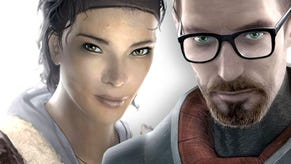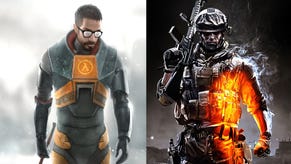Half-Life 2
Moves the goalposts. With a gravity gun.
Order yours now from Simply Games.
It's 8.19am on November 16th 2004.
The rising vapour from a half consumed cup of tea forms into an upside down Y in a circle, or at least that's what it looks like from the perspective of someone who's been up since 5.30 AM getting everything ready. Steam has just finished its file validation process for Half-Life 2; the tedious, heinous, torturous delays and drip feed of information is almost over. Six long years. Six years since we finished the first wondrous, eternally memorable game. A time before Xbox, Game Boy Advance, PS2, Dreamcast. A time when Voodoo 2 was king. A time before Eurogamer was even a foetus.
We check the forum to while away the minutes. Predictably it's awash with eager, like-minded souls, posting their progress with the validation (or lack of). We weren't told about this! Why can't it just work? Why the inexorable torture? We own the game, let us play it dammit! 18%. More postings. 29%... Nggggggh... 59%... 82%... A long pause. What's going on? We don't get to see anymore. Before the magic numbers up to 100 can appear, we're presented with a black screen. Uh oh. Not of death, thankfully. Of life. Half-Life. 2.
Route Kanal surgery

At this point the Internet is quite possibly melting as hundreds of thousands of devotees all around the world simultaneously stress Valve's servers to breaking point. We haven't seen the likes of it. It's truly a momentous, agonising wait as we cross fingers and toes that Valve hasn't screwed up and underestimated demand; we were fearful, but like something approaching the Space Shuttle launches of our youth over two decades past, we have lift off.
But not everyone has such a smooth, seamless ride. As we rocket into the stratosphere we can just about make out the crimson faces of those left behind, venting furious, jealous, indignant anger at Valve for managing to mess up their dream journey, furious that even retail boxed copies fail to authenticate. It's a moot point, and a discussion that's still raging.
But after the roar of take off, a serene silence gives way. The G-Man looms large and loud and it takes somewhere in the region of two seconds to realise what all the fuss is about. Another stylish intro. A quickening of pulse, a shallowing of breath. A downtrodden yet magisterial air as another commuter journey begins. An atmosphere to savour. An oppressive beginning that gives a small taster of what we're about to experience; a world we have been trying hard to imagine for months, years. Blocking it out of our minds, trying not to spoil it for ourselves, yet filling time and column inches with games barely even worthy of the name, rushed out into the market only to let us down and chip away at our eternally optimistic resolve. Valve's approach was different. Valve's purpose was to take things forward whatever it took, however much it cost, and seemingly no matter how many people it pissed off along the way. And now the future is here.
Dr Freeman I presume
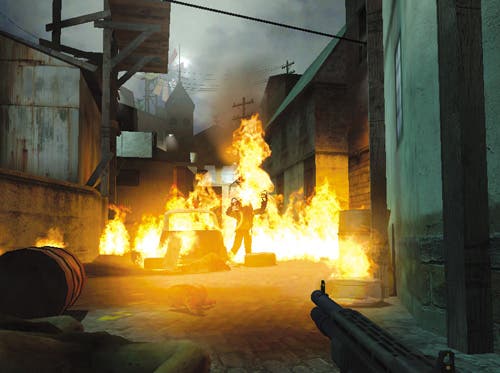
If Half-Life 2 achieves one single thing, it's to put into sharp focus how far gaming has come, and more specifically how far behind some of its competitors in the FPS genre really are. Some doubted that the Source engine could match the technical brilliance elsewhere, but it has not only surpassed anyone else's achievements, it has done so without forcing people to invest in ludicrously expensive hardware. Reports persist from amazed gamers with mid-range set ups that have been blown away by how well the game runs on their systems. That Half Life 2 looks more convincing, more understated, more realistic, more interactive and definitely more stylish than its peers yet manages it with far lower overheads is not only an impressive feat, but commercially a masterstroke. Not letting a fair chunk of your loyal customer base play the game because your content delivery system can't cope, however, isn't - although some would argue that the fact that a hacked version of the game didn't appear until day of release meant that the ends were worth the means. To an extent we'd have to agree; how much more money was earned as a result of slowing down the hackers we'll never know; but a hunch says it's a lot.
But we don't want to get bogged down in the relative merits of Steam, the shoddy packaging of the boxed version or any of the periphery issues that have clouded this momentous launch (the forum's choked with enough vitriolic bile to melt Gabe Newell's face as it is). We're here to talk about the game. And what a game. 14 chapters, 18 or more hours (skill/approach dependent) of almost relentless, fat free entertainment that's the gaming equivalent of watching several blockbuster action movies back to back. If this game isn't worth the asking price, we don't know what is.
Sometimes we like to utter a few sentences on the back story to give you a flavour of what to expect, but Valve being Valve has elected to keep things as enigmatic as possible. It's not possible to know this by just playing the game (and there's no manual anyway), but apparently the game takes place 15 years after the Black Mesa incident. No one knows (or even hints) what has happened in the intervening years, or why you're on your way to City 17, or what role you're supposed to perform once you get there. Suffice to say it's a grand city under an oppressive police state rule, with scary looking Tazer wielding-grunts (known as the Combine) armed to the teeth should anyone step out of line. It's part Big Brother, part Matrix with Eastern European architecture lending the setting an impossibly beautiful backdrop almost totally at odds with the climate of fear that perpetually pervades the environment.
A man of few words
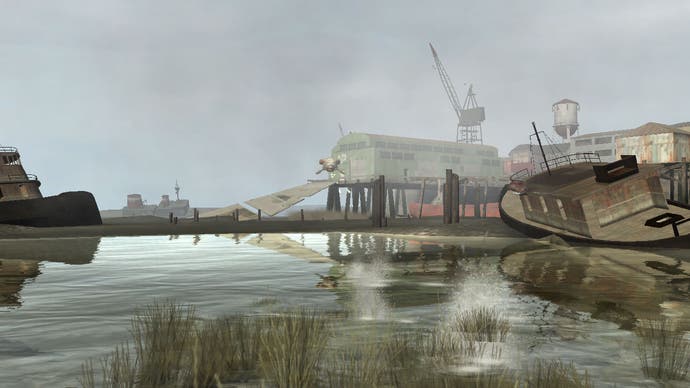
Although this is 'the future' we're dealing with, it's a more realistic vision of the future, blending the more pleasing elements of the architecture of past with the cold sky scraping steel monoliths of the future. This isn't A.N.Other Blade Runner rip off, with neon skylines and hover vehicles. It's something distinctly fresh, and believable, all rendered with craft, life, logic and intelligence. If the devil is in the detail, then Half-Life 2 is Satan in a party hat, kicking back with a beer and engaging his fiendish accomplices in a toast to the future. Cheers.
The moment you start wandering the game's first locations a feeling of arriving somewhere special kicks in and barely lets go until the credits roll 13 chapters later. As if to deliver a cheeky nod about being in a new playground, Valve even drops one in the game's opening location, almost entirely pointlessly, other than to remind us all that's what this is all about. It's not about re-inventing the wheel, but pimping up that wheel with spinning hubcaps, bass boxes, neon strips and gadgets that would humble even Bond himself.
But Freeman is no double-O. If anything, he's the most personality-free zone in the history of gaming. Once again he never speaks, you never see him (not even so much as a reflection) yet everyone greets him like the ultimate living legend. Not bad for a "man of few words". If he ever uttered a thing our hearts would probably stop with the shock, but somehow the game gets away with pulling the same silent narrative trick of the original, engaging you this time with characters of far greater emotional depth than any FPS has dared to venture. All of this comes, as the original pioneered so successfully, from a combination of scripted set pieces that you watch silently unfold and various events that kick off with your arrival. By necessity and by design it's another story-lead on-rails shooter, and can only stray outside of those barriers to a minimal extent. To some this may come as a slight disappointment when it transpires that there is generally only one way to solve whatever your current dilemma is, but where Half-Life 2 succeeds beyond any doubt is in its ability to consistently and repeatedly create richly diverse and believable environments that enrapture the play experience with a suspension of disbelief that makes the thrill ride just as enjoyable as we expected to be.
Just like any game there are high points and low points, but when you bask in the warm glow of completion there are so many high points to recall it seems almost pointlessly pig-headed to find serious fault with what you've just experienced. If you can seriously come away from Half-Life 2 disappointed, then ask yourself which first-person shooter is better, and why? For the vast majority of us, the overwhelming emotion will be the pure joy of having experienced something that sets new high marks in so many areas as to reaffirm your belief in the ability of game developers to push things forward.
No Phantom Menace

It's probably fair to note that, with the exception of The Chronicles Of Riddick, no other game connected to the FPS genre released in recent years has done more than make things prettier. Even Doom III and its magnificent later levels were essentially a retread. Far Cry had the right idea with its approach to freedom (and arguably leads the way in that respect), but it lacked style, and the atmosphere failed to engage. The important point to make is that Valve hasn't just spent the last five or so years making a pretty sequel. On so many levels Half-Life 2 nails just about everything you could want from a sequel; the best things we can think of it that it still feels like Half-Life. It stays true to the essence of Half-Life, while at the same time improving on most of the various components that made the original such a landmark gaming experience. Before we launch into a breakdown of what we mean by that, the overriding point is that it's fun all the way through. Regardless of what we think of the art style, or the storyline or the weapons, or the physics or the myriad of issues surrounding the game, it's the most intensely enjoyable assault on the senses we've played this year. Probably ever. At the moment, it doesn't get any better than this.
One of the things that made Half-Life stand out was the narrative technique, not to mention the outstanding voice work and subtlety coherent journey, that gave the gamer only as much information as they needed to get to the next part of the game - tricking the gamer into believing they had to escape impending disaster, and then slowly unravelling a hugely entertaining conspiracy. This time around it's not quite so limited with the player often tasked with traversing vast distances, taking in hugely varied terrain and locations as opposed to keeping the player tethered to a base of operations. But while it's true that a relatively small part of Half-Life 2 takes place within the central core of City 17, the sense of variety and freshness is extremely welcome. In terms of the actual story, it's probably even less clear as to why you're there or what you're ultimately supposed to be doing than before. Along the way it takes in familiar themes of escape, rescue, betrayal, revenge and, of course, redemption.
On the surface there's nothing inherently unique or special about the story - how many times have we seen those narrative themes used? Probably in every single game at some stage, in truth. But yet the incredibly lifelike detail and unparalleled attention to detail in the facial and body animation bring the characters to life like no game has ever even come close to doing. Six years ago there were a handful of facial models, bags of imagination and some great voice work; now we've got a huge cast list who all have plenty to say (with impressively accurate dynamic lip synching) and do so with such an impressive array of visible emotions that infuse the game with a head-turning credibility that will change the way people view games forever. The narrative possibilities within gaming are still in their infancy, but Valve is most definitely leading the charge with technology that takes a gigantic leap forward in making games that barely even look like games anymore.
The emotion engine
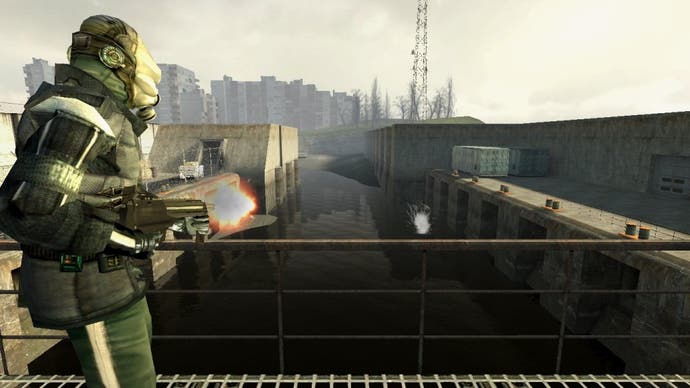
In terms of the way the rest of the game looks, it's hard to even begin to emote how impressive it is. On an admittedly unnecessarily large screen, the visual spectacle is almost too much to take in. It took this reviewer far longer to finish the game than most other people, it seems, but you can blame a lot of that tardiness on the amount of time spent picking up a perpetually flopping jaw from the floor. And the beefier the kit, the bigger the screen, the more deliciously exquisite the scene becomes. But regardless of screen size it can't be overemphasised how spectacular the whole thing looks, with a physical presence to the environment that's no longer restricted by the box-like level designs of old; a majestically constructed environment that above or below ground, inside or out, hits new heights of artistic excellence that make every potentially mundane step of your journey an eye-popping feast to savour.
And this physicality we spoke of extends so much further than mere eye candy. For the first time the promise of advanced physics actually means more than watching a barrel roll down some stairs or an unconvincing rag doll animation. For the first time it's truly part of the experience, and it's all the better for it. [Potential spoiler alert: If you don't want to read about a new weapon in the game then skip to the next paragraph.] It's a new toy in a new playground, where the toy is the Gravity Gun and the playground is what you see. If you haven't seen any of the numerous official videos doing the rounds over the past 18 months then essentially it gives Freeman the incredibly useful ability to pick up and throw inanimate objects otherwise too heavy to haul around, namely barrels, radiators, furniture, saw blades and even bombs. At first this appears to be a means to floor opponents in a slightly more impressive fashion than just shooting them, but soon it becomes an essential part of getting around levels, allowing you to negotiate deadly environmental hazards that you might not necessarily want to walk over without constructing something first.
Mercifully, the puzzle element of the game is but the tiniest fraction of the overall picture, and when it does arrive serves as a bit of a breather from the often relentless combat you find yourself engaged in. Only on the fourth chapter does the puzzling stand a chance of holding players up for long (and dear god did it hold this reviewer up, as the forumites will acknowledge), with at least three occasions where having your wits about you is every bit as important as your aim. Once or twice thereafter your brain is called into action, but for the majority is action all the way, with only the merest sliver of platforming negotiation necessary, you'll be relieved to hear.
Combat rocks
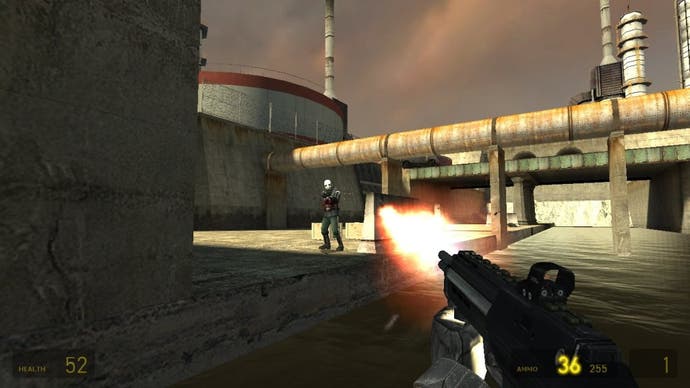
So what of the combat and its partner in crime, AI? Well, it's fair to say that we enjoyed it immensely, being pitched perfectly in terms of difficulty (on Normal) neither being too easy or too troublesome that it becomes a quicksave fest. Some elite players out there have reported they found it easy, but this is coming from the type of people that perform headshot kills in CS while asleep, so don't listen too much to them. Mortals will delight in the AI for the most part - while it's true that most of the time enemies show rather too much of themselves to be truly convincing adversaries, there's a fair amount of ducking, dodging and outmanoeuvring to light up the scene and make even the most tame encounters into something never less than enjoyable. Frankly we'll never ever tire of hearing the ZX Spectrum load noises that emit from the Combine's masked bodies as they shuffle loose the mortal coil.
Other nasties abound, naturally, with only the dreaded Head Crabs and their shag buddies returning for a second bow, but without giving anything away or wishing to spoil the surprise, they really do never let you down. If there's one tiny criticism it's that there aren't actually all that many different enemies and that you've seen virtually all there is to see on the weapons/enemy front by the time you're halfway through. Personally we'd have thought a gradual, consistent, yet varied introduction of new things to fight and new things to fight them with would have been a good plan, but then, having said that, just when you think things can't get any more insane Valve go and spring a few things on you towards the climax just to make you realise that you're in one hell of a battle...
Anticitizen four
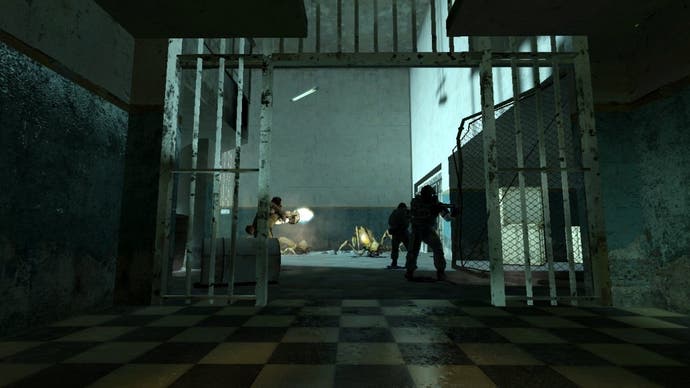
In terms of buddy AI, much has been improved upon, but it's still a little two-dimensional at times. Barney's role from the original has been vastly elevated since his generic security guard position last time out, but the willing army of helpers who greet Freeman with a hero's welcome periodically in the latter stages of the game are all too happy to cop a bullet in the name of freedom. Rather than merely being a bunch of generic resistance fighters, though, with the same faces, each one looks unique in its own right and in a style not dissimilar to Call Of Duty will help out in firefights, with one of the four-strong squad performing ammo replenishment duties and another doling out medipacks, although all of them prove to be ultimately dispensable. Slightly uselessly you can 'command' them in the loosest sense of the word, being able to direct them to head to a point determined by your sight reticule. But apart from perhaps shielding them from the line of fire there appears to be no reason to do anything other than let them follow you around in the hope that they might take out one or two Combine soldiers. To be fair, not many people would have wanted HL2 to be Rainbow Six anyway (although a squad shooter in the HL universe would be an amazing prospect), but it would have been interesting if the straight up all action shooting emphasis could have morphed into a few missions requiring a more careful, stealthy approach. There is a world to save, after all; you'd think the resistance would want to be a more careful bunch than to just wade in and cop bullets just like that, but like lemmings they drop dead time after time. It's possibly the only thing in the entire game that chips away at the suspension of disbelief. Shame.
However, one of the more remarkable things about Half-Life 2 is that even after all these years when the genre's effectively been 'done to death' (or so it seemed), Valve has still managed to supplement the consistently excellent combat with a satisfying selection of original ideas that although largely borrowed from the first game still don't feel tired. Of the new weapons, the Gravity Gun is almost unlimited in the amount of fun you can have with it, while the Combine Assault rifle and its hugely entertaining alt-fire is most definitely the traditional firearm of choice - possibly one the best weapons ever to feature in a videogame with its almost instant reload and wonderfully powerful feel. Could Valve have put more new weapons in? Yes, without a doubt. It's a mystery given how long the game is that more isn't added to your bulging arsenal, but we're only saying this upon reflection. At the time it's not really an issue; what you have is certainly more than enough, and very little of what you carry around with you isn't vital at some stage. Even the raggedy-arsed pistol has its uses thanks to the ability to spit out a surprising amount of bullets in no time with an epileptic trigger finger.
Vocally speaking
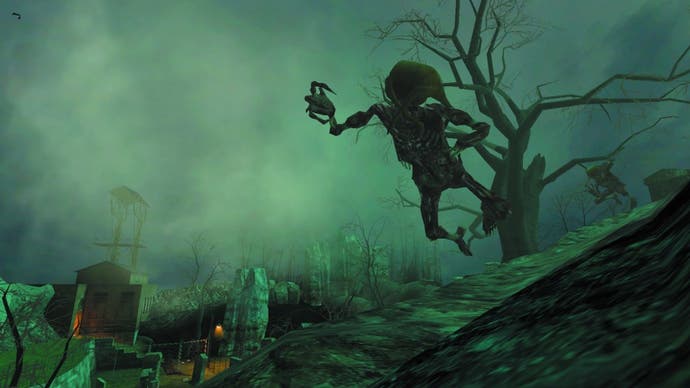
As you'd expect from Valve, the sound effects and general ambient audio is probably the best there is. Apart from the ongoing issues many users are experiencing with stuttering audio (something Valve has acknowledged and is working on fixing) the main characters don't quite have the vocal charm of the original, but still hit the mark, while the immensely atmospheric radio chatter and occasional snatches of conversation from both buddy AI and enemy patrols lend HL2 the kind of atmosphere we've been craving from so many games, yet appear to be beyond the capabilities of most developers.
With the level of filmic ambition and quality lavished upon the game, it's inevitable that certain eternally unimpressed people will be going all out to tediously pick apart various elements in an attempt to take something away from Valve's achievements - and yes, looked upon under a microscope you'll start to see the little elements that could have been improved. For some, it's merely a question of gameplay preference with some expressing tiredness for scripted FPS after years of being saturated in them. For others it's technical odds and sods that still remind you you're 'only' playing a videogame; the somewhat forgiving AI, the lemming-like buddy AI, the continued use of scripted, restrictive environments, the slightly irksome physics puzzles.
Yes, Half-Life 2 is not the perfect game. No game is, especially one that tries to take on the ambitious task of simulating elements of the real world, but once you take Half-Life 2 in the context of what it is and what it excels in, as opposed to what you thought it might be or could be, then it's startlingly clear that we're dealing with the game of the year. Never before has a game shouted 'ten out of ten' to us from the opening seconds to the last, and if this is a sign of what's to come in the next generation, then we're not likely to be changing our hobbies any time soon. If there's another game out there capable of evoking such consistently bewildering and dizzying excitement then we're not aware of it.






